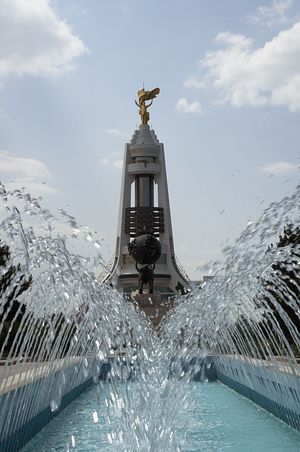Turkmenistan’s chronic water shortages are increasing in severity. While water is a critical problem for much of the region, Turkmenistan’s crisis is particularly acute.
On July 10, RFE/RL’s Turkmen service, known locally as Azatlyk, posted a video of Ashgabat’s citizens carrying empty buckets to retrieve water. One of the women in the video states that “last week there was no gas, and today there is no water. We have guests over, and yet, not even a single drop of water in our home.”
The crisis is not limited to Ashgabat; the entire country has been affected. In Balkanabat City, for example, residents went three days in a row without water. Local officials said that the central pumping system was out of order and it was unknown when it would be fixed. However, no alternative water supplies were offered to the city’s 120,000 inhabitants.
In Turkmenistan, shortages can be particularly dangerous. In June 2015, Turkmenistan suffered its hottest month in recorded history, with temperatures soaring as high as 47.2 degrees Celsius (116.96 F).
“We Have Brought New Life to These Once Lifeless Sands”
The Karakum Desert, with an average annual precipitation of 0.47 inches, covers 80 percent of Turkmenistan’s surface. Currently, the country is regarded as the ninth most water insecure in the world, with many specialists arguing that a serious water shortage will occur as early as 2020.
Despite this unforgiving climate, the government has invested millions in urban greening projects, including mass planting campaigns and the development of huge parks. These projects can only be sustained by large quantities of water, via irrigation, sprinkler systems, or water trucks.
In the first step of his desert greening project, President Gurbanguly Berdymukhammedov signed a decree in 2013 ordering the planting of over three million trees. The so-called “grand greening action” involved 465,000 people – more than one-tenth of the population. In addition, steps were taken for the maintenance of 1.6 million saplings which had been planted earlier.
Turkmenistan’s elites lack foresight concerning the survival prospects of plants that heavy depend on irrigation to keep them alive. Vegetation throughout the country is dying at an alarming rate – including trees planted by foreign dignitaries at the National Independence Monument. The tree planted by former Ukrainian president Victor Yanukovych in 2009, for example, is now brown and sickly.
Seeking to construct an image of Ashgabat as an “urban oasis,” city planners have diverted water from the Amu Darya into the many fountains adorning public spaces. Despite the country’s water insecurity, Ashgabat entered the Guinness Book of Records in 2008 for having the greatest number of fountain pools in a public space. However, many of Ashgabat’s fountains have been suffering from the recent water shortage, and have been inactive since July 3.
Engineering Ecosystems
Compounding these problems is the state’s agricultural strategy.
Currently, the regime is attempting to attract $1 billion in foreign investments by 2016 to expand its cotton industry, which will necessitate the expansion of irrigated land, thus increasing the agricultural demand for water. A desert environment such as Turkmenistan’s, with high temperatures and low humidity, means heightened water requirements of up to 50 inches per year to grow cotton.
Problematically, the country remains entirely dependent on water from the Amu Darya. The river is entirely supplied by permafrost run-offs; some experts are predicting permafrost melt, causing a 15 percent flow reduction by 2050.
Moreover, artificial wastage rapidly accelerates the process. Re-directing the Amu Darya is the vast Karakum Canal, the largest in the world, which carries 13 cubic kilometers of water annually over to support 3,800 square miles of cropland. Like most Soviet-era irrigation canals, the Karakum Canal was unlined, consequently losing up to 30 percent of its total flow each year. Worse, this seepage has caused massive waterlogging and salinization of the surrounding land, making an estimated 35 percent of irrigated land in Turkmenistan unusable.
In a characteristically bombastic move, the government is now flooding the Karashor depression in northern Turkmenistan through an extensive network of tributary canals to create the Altyn Asyr, ‘Golden Age Lake.’ Turkmen officials say the lake will help drain the water-logged cotton fields and encourage plant life, as well as encourage migratory birds toward the desert.
Environmentalists disagree, arguing that a lot of the water will simply disappear into the desert’s permeable soil, leaving it extremely salty. Moreover, it is not only salt that remains, but pesticides too. Dust storms will potentially splay these up to 300 miles, potentially harming both the health of the population as well as crops.
With this compendium of man-made problems for the Turkmen state, the future looks bleak. Rather than investing state funds in social welfare programs and effective water management schemes, elites have been enticed by the power of their own spectacle.
Bradley Jardine is a Central Asia researcher and writer currently interning with RFE/RL.

































